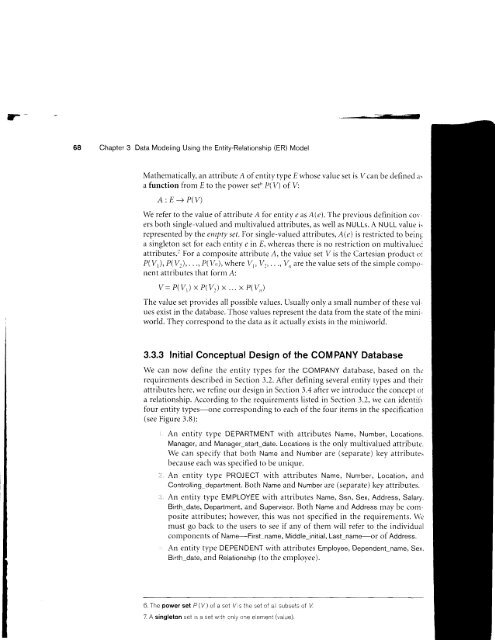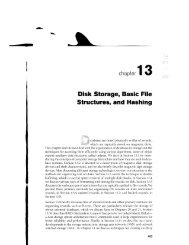this pdf excerpt
this pdf excerpt
this pdf excerpt
Create successful ePaper yourself
Turn your PDF publications into a flip-book with our unique Google optimized e-Paper software.
F-<br />
Chapter 3 Data Modeling Usrng the Entity-Relationship (ER) Model<br />
Mathematically, an irttribute A of entity type E rvhose value set is V can be clef-ined a.<br />
a function from E to the power set6 P(V) of V:<br />
A: E --> P(V)<br />
We refer to the value of attribute A fbr entity e as A(e). The previous definition cor -<br />
ers both single-vah"red and multivalued attributes, as well as NULLs. A NULL value i.<br />
represented by the entpty ser. For single-varlued attributes, A(e) is restricted to beinc<br />
a singleton set for each entitv e in E, whereas there is no restriction on multivaluec<br />
attributes.T For a courposite attribute A, the vaiue set V is the Cartesian product or<br />
P(yr), P(\/),. . ., P( l.',,), where \1,, y,, . ., {, are the value sets of the simple component<br />
attributes that tbrm A:<br />
V= P(Vr) x P(y:) x ... x P(y,,)<br />
The value set provides all possible values. Usually only a small number of these values<br />
exist in the database. Those values represent the data from the state of the miniworld.<br />
They correspond to the data as it actually exists in the miniworld.<br />
3.3.3 lnitial Conceptual Design of the COMPANY Database<br />
We can now define the entity types for the COMPANY database, based on thc<br />
requirements described in Section 3.2. After defining several entity types and their<br />
attributes here, we refine our design in Section -1.4 after we introduce the concept of<br />
a relationship. According to the requirenlents listed in Section 3.2, rve crrn identif\<br />
four entity types-one correspronding to each of the four items in the specification<br />
(see Figure 3.8):<br />
'<br />
An entity type DEPARTMENT rvith attribr-rtes Name, Number, Locations.<br />
Manager, and Manager_start_date. Locations is the or-rly multivaiued attribute.<br />
We can specifl' that both Name and Number are (separate) key attributes<br />
because each was specified to be unique.<br />
:: An entity type PROJECT with attributes Name, Number, Location, ancl<br />
Controlling-department. Iloth Name and Number are (separate) key attribr-rtes.<br />
::, An entity type EMPLOYEE with attributes Name, Ssn, Sex, Address, Salary.<br />
Birth_date, Department, and Supervisor. Both Name and Address may be con-rposite<br />
attributes; however, <strong>this</strong> wrrs not specified in the requirements. \{e<br />
must go back to the users to see i[ any of them rvill ref-er to the individual<br />
components of Name-First name, Middle_initial, Last name-or of Address.<br />
' An entity type DEPENDENT with attributes Employee, Dependent_name, Sex.<br />
Birth-date, and Relationship (to the employee).<br />
6, The power set P(V) of a set / s the set of alL subsets of V<br />
7 A singleton set s a set wrth only one eLement (value),














